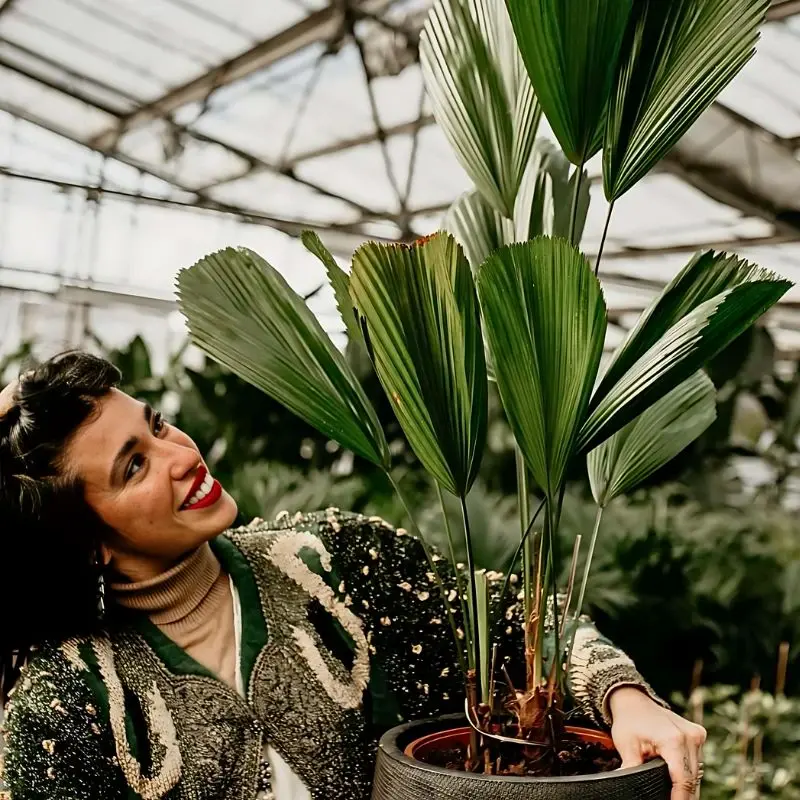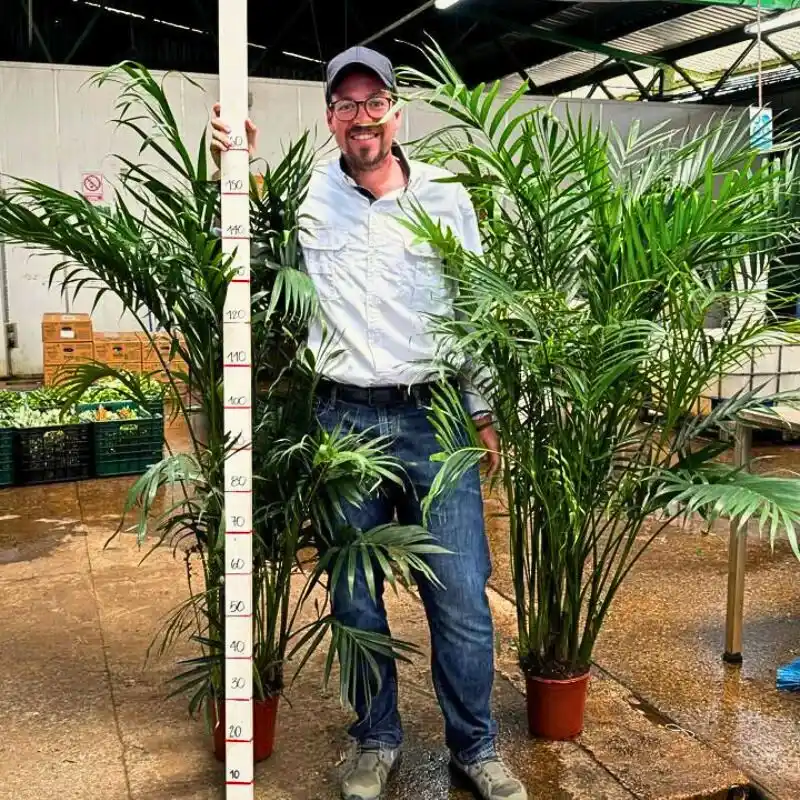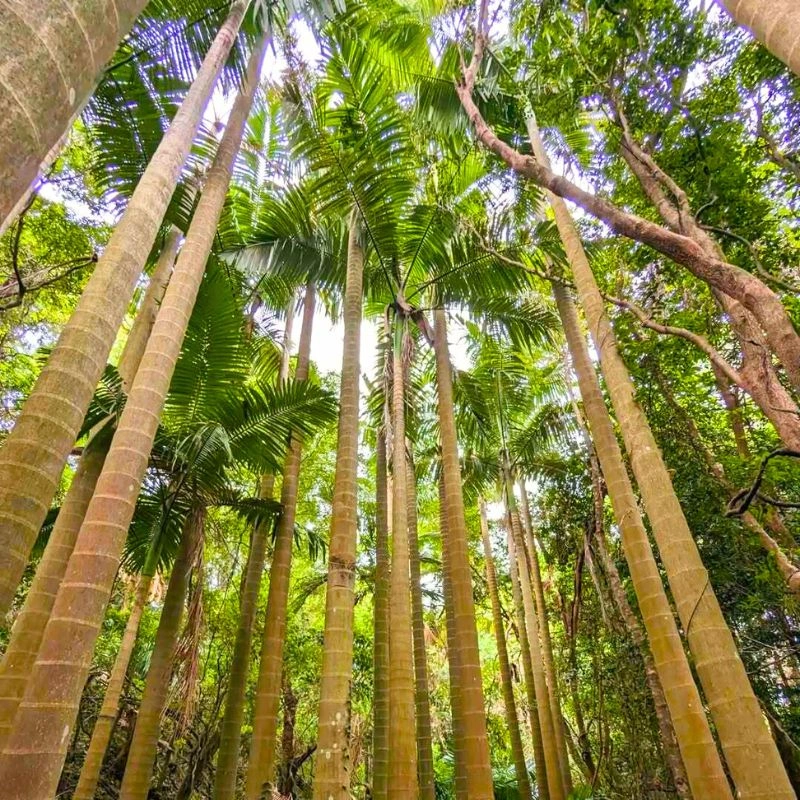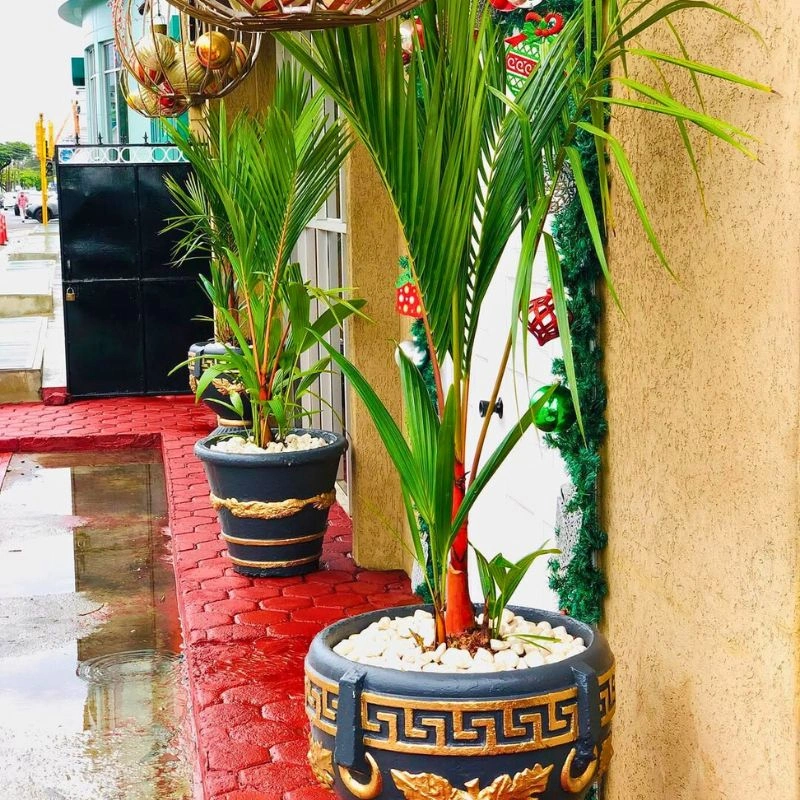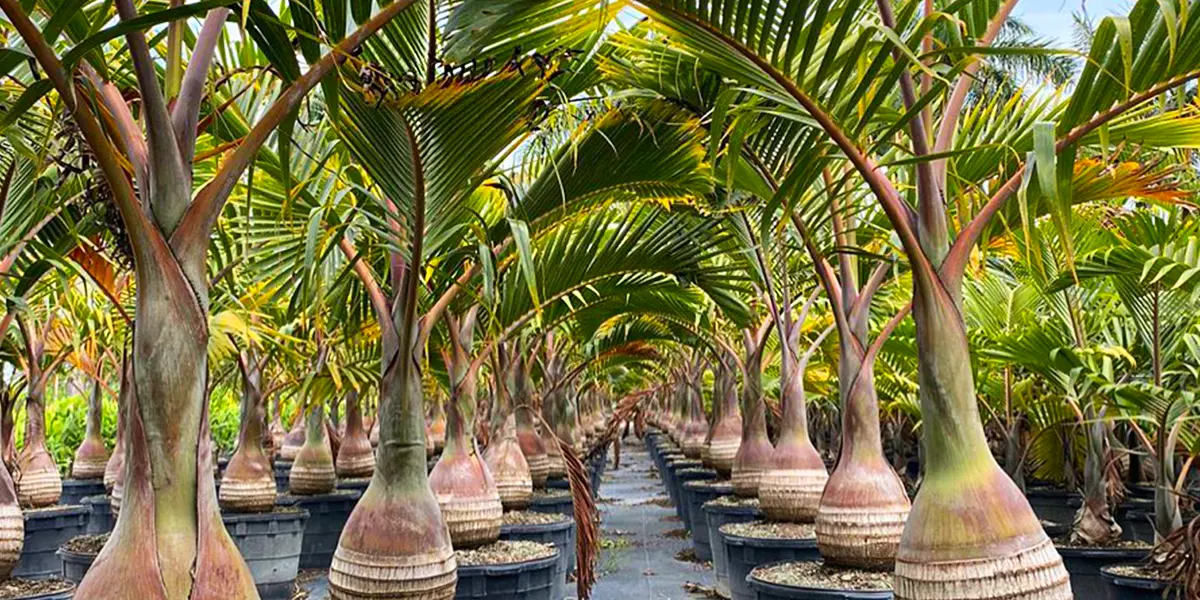The King Palm Tree (Archontophoenix alexandrae), also known as the Alexandra Palm or Alexander Palm, is a stunning addition to any garden or landscape. With their graceful crown, lush green fronds, and tall, elegant trunks, these tropical beauties thrive in warm climates and can transform your outdoor space into a tropical paradise.
Whether you live in San Diego, Southern California, or another warm region, this guide will help you grow and care for your King Palm tree, ensuring its longevity and optimal growth rate. If you want to check out more about tropical garden palm trees, here is an exhaustive list for you.
Choosing the Right Location for Your King Palm
Selecting the ideal location for your King Palm (Archontophoenix alexandrae) is crucial to its health and growth, whether indoors or outdoors. This tropical beauty thrives in warm, humid environments with filtered sunlight, making placement a key factor in its longevity.

Outdoors, King Palms need well-drained soil, protection from strong winds, and partial shade to prevent sunburn. Indoors require bright, indirect light and consistent moisture to maintain their lush, green foliage. Choosing the right spot ensures your palm remains vibrant, resilient, and an elegant addition to your space.
Sunlight Requirements for the King Palm Trees
King Palms grow best in full sun but can tolerate partial shade. Choose a location that receives plenty of sunlight throughout the day for optimal growth. However, if you live in an area with intense afternoon sun, a spot with some shade during the hottest part of the day can prevent leaf scorch.
Reviewing the Soil and Drainage for Growing King Palms
These palms love well-draining soil with a pH between 6.0 and 7.0. Avoid planting in areas with standing water, as this can lead to root rot. If your soil is heavy or clay-like, amend it with peat moss and perlite to improve drainage.

Space Consideration for Planting Your King Palm
King Palms can grow up to 25 meters (80 feet) tall outdoors, so their mature size must be considered when selecting a location. Ensure there’s enough space for the tree to grow without interfering with structures or other plants.
Indoors, King Palms typically reach a height of 1.6 to 3.5 meters (6 to 12 feet), depending on the size of the pot and growing conditions. When placing one indoors, choose a spot with ample vertical space to accommodate its growth while ensuring it doesn’t outgrow the room. Regular pruning and repotting can help manage its size and keep it thriving indoors.
Planting and Growing King Palms
King Palms are prized for their elegant, tropical look and relatively low-maintenance care, but proper planting and growing conditions are key to their success. Whether you’re planting them in the ground or a container, these palms require well-draining soil, consistent moisture, and the right balance of sunlight. With the right care—adequate watering, occasional fertilization, and protection from extreme temperatures—your King Palm tree can flourish, adding a lush, tropical touch to your landscape or indoor space.

Planting Tips for Growing A Healthy King Palm Tree
For outdoor planting:
- Dig a hole twice as wide and just as deep as the root ball.
- Place the tree in the hole, ensuring the top of the root ball is level with the ground.
- Backfill with a mix of native soil, peat moss, and perlite.
- Water thoroughly after planting to help the roots establish.
For container planting:
- Choose a large, well-draining pot to accommodate root growth.
- Use a high-quality potting mix with good aeration, such as a blend of peat moss, perlite, and sand.
- Position the palm so the root ball sits at the same level as in its previous container.
- Water thoroughly and place in a bright location with indirect sunlight.

Watering and Fertilizing Your King Palm Tree
King Palms love water but are susceptible to overwatering. Water regularly, especially during the growing season, but allow the soil to dry slightly between waterings. Avoid watering the trunk directly, as this can cause damage.
Use a balanced fertilizer or a palm-specific fertilizer during the growing season to promote healthy growth. Apply fertilizer every few months to provide essential nutrients.
Soil and Watering for King Palm Trees
A well-draining soil mix is crucial for King Palms. Combine peat moss, perlite, and organic matter to create a nutrient-rich environment. For potted palms, use a palm-specific potting mix.
Apply a layer of mulch around the base of the tree to retain moisture, suppress weeds, and regulate soil temperature. Keep the mulch a few inches away from the trunk to prevent rot.
Temperature and Humidity Requirements That Fit King Palm Growth
King Palms thrive in warm climates with temperatures between 18-24°C (65-75°F). They are well-suited for USDA zones 10-12 and can tolerate a range of temperatures, but they prefer consistent warmth.

These palms enjoy a humid environment but avoid misting the leaves, as this can lead to fungal diseases. If you’re growing King Palms indoors, maintain a humidity level of 50-60%.
Pruning and Training Your King Palm Tree
- Remove old fronds and dead or damaged fronds to maintain the tree’s appearance and promote healthy growth.
- Minimal pruning is required, as King Palms naturally shed their lower fronds.
- Remove seed pods to encourage healthy growth and prevent flowering, which occurs randomly.
To encourage an upright growth habit, remove lower fronds and provide support if necessary. This helps your king palm tree develop a strong, straight trunk.
Pest and Disease Control for King Palms
- Spider Mites – These tiny pests suck sap from the leaves, causing yellowing and webbing on the fronds. Treat infestations by spraying the leaves with water, applying insecticidal soap, or using neem oil.
- Mealybugs – These white, cotton-like insects cluster on the stems and leaf bases, weakening the plant. Wipe them off with a cotton swab dipped in alcohol or use insecticidal soap.
- Scale Insects – These hard-shelled pests attach to the trunk and leaves, feeding on sap and causing yellowing. Scrape them off gently or treat them with horticultural oil.
- Fungal Leaf Spot – Caused by excessive moisture, it appears as brown or yellow spots on the fronds. Improve air circulation, reduce overhead watering, and apply a fungicide if necessary.
- Ganoderma Root Rot – A deadly fungal infection that causes wilting, stunted growth, and a conk (mushroom-like growth) at the base of the trunk. Avoid overwatering, ensure proper drainage, and remove severely affected trees as there is no cure.
- Pink Rot – A fungal disease that causes wilting, rotting, and pink spore masses. Prune affected areas, improve soil drainage, and treat with a fungicide.
Repotting and Potting King Palms
Repotting your King Palm every 2-3 years keeps it healthy and prevents root crowding. The best time to repot is in spring or early summer. Choose a pot only slightly larger than the current one, with proper drainage to avoid water retention and root rot.

Use a well-draining mix of peat moss, perlite, and pine bark. Gently remove the palm from its old pot, loosen any bound roots, and place it in the new pot at the same depth. Fill with fresh soil, lightly pressing to remove air pockets. Water thoroughly after repotting and place the palm in bright, indirect light. Avoid overwatering while it adjusts, then resume regular care after a few weeks.
Propagation Methods for King Palm Tree
King Palms are primarily propagated through seeds, which require warmth, humidity, and patience to germinate. Fresh seeds have a higher success rate and should be soaked in warm water for 24 hours before planting to soften the outer shell. Sow them in a well-draining potting mix, such as a blend of peat moss and sand, and keep the soil consistently moist but not soggy. Placing the container in a warm, humid environment, like a greenhouse or covered pot, helps speed up germination, though it can still take several months for seedlings to emerge. Once sprouted, young palms should be gradually exposed to more light and transplanted into larger containers as they grow.
.

While less common, division can also be used to propagate King Palms, especially when dealing with clumping varieties. This method involves carefully separating offshoots or suckers from an established plant, ensuring each division has a portion of healthy roots. The separated plants should be placed in well-draining soil and kept in a warm, shaded area until they establish new growth. Though effective, division can be stressful for the plant, so it’s important to minimize root disturbance and provide consistent moisture to aid recovery.
Indoor Care for King Palms
King Palms need bright, indirect light, best near an east- or west-facing window. Avoid direct sunlight to prevent leaf burn and rotate the plant occasionally for even growth. Keep temperatures between 65-75°F (18-24°C) and humidity at 50-60%. Avoid cold drafts and dry air by misting, using a humidifier, or placing a water tray nearby.

Water when the top inch of soil is dry, ensuring proper drainage to prevent root rot. Reduce watering in winter. Fertilize with a half-strength liquid palm fertilizer once a month during spring and summer. Proper care keeps your King Palm lush and healthy indoors.
Landscaping With King Palms
King Palms are a landscaper’s favorite due to their striking elegance and versatility. Their tall, slender trunks and lush fronds make them perfect focal points in gardens, whether planted as standalone specimens or in groups to create a tropical canopy. When clustered, they provide shade and a serene, resort-like ambiance, enhancing backyard spaces with a lush, green aesthetic. Their graceful presence also makes them ideal for street and avenue planting in warm climates, where they add sophistication to urban landscapes. Additionally, their non-invasive roots make them a safe and practical choice for poolside planting, offering a cooling effect while maintaining a clean, refined look.

Beyond aesthetics, King Palms contributes to eco-friendly landscapes by attracting wildlife such as birds, hummingbirds, and butterflies, bringing life and movement to gardens. They are also well-suited for container planting, making them a great option for patios, balconies, and indoor spaces with bright, indirect light. Their adaptability allows them to thrive in various settings, from grand estates to compact urban spaces, making them a valuable addition to any landscape design. Whether used to frame walkways, line driveways, or create tropical oases, King Palms provide timeless beauty with minimal maintenance, ensuring lasting visual appeal.
Outdoor Care for King Palms
Caring for King Palms outdoors requires regular maintenance to keep them healthy and thriving. Prune dead or damaged fronds to encourage new growth and maintain their appeal. To provide essential nutrients, fertilize regularly with a balanced, slow-release palm fertilizer, especially during the growing season. Since King Palms prefer warm, humid climates, they should be protected from extreme weather conditions like strong winds and frost, which can damage their fronds.

In landscaping, these palms add a lush, tropical touch, whether used as striking specimen trees or planted in clusters to create a dense, canopy-like effect. They pair well with understory plants like ferns and bromeliads, enhancing the overall tropical aesthetic. Proper placement, watering, and occasional care will ensure your King Palm remains a stunning feature in any garden or landscape.
King Palm Tree Varieties
The most common variety, also known as the Alexandra Palm or Alexander Palm, is prized for its graceful crown and fast growth rate. It is a favorite for both landscaping and indoor cultivation.
Other varieties of king palm tree include:
- Archontophoenix cunninghamiana (Bangalow Palm or Northern Bangalow Palm): Slightly less common but equally stunning, this variety is more tolerant of colder temperatures and adapts well to different environments.
- Archontophoenix maxima is the largest of the King Palms. It boasts a more robust trunk and broader fronds, making it an excellent choice for those seeking a more dramatic tropical statement.
- Archontophoenix purpurea (Purple King Palm): A rare variety distinguished by its striking purple crown shaft, adding a unique touch to any landscape.
- Archontophoenix myolensis: A lesser-known variety with slightly more compact growth, ideal for smaller spaces or container planting.
With the right care, King Palms can flourish and bring a lush, tropical feel to any space. Whether planted in the ground or a pot, their graceful fronds and elegant presence make them a striking addition to your garden or home. These palms not only enhance the landscape but also create a serene, refreshing atmosphere.

By ensuring proper light, watering, and occasional maintenance, your King Palm will continue to thrive for years, offering shade, beauty, and a touch of the tropics to your surroundings. With patience and attention, you’ll enjoy a healthy, vibrant palm that elevates any indoor or outdoor setting.
Header image by @SVK Nursery


